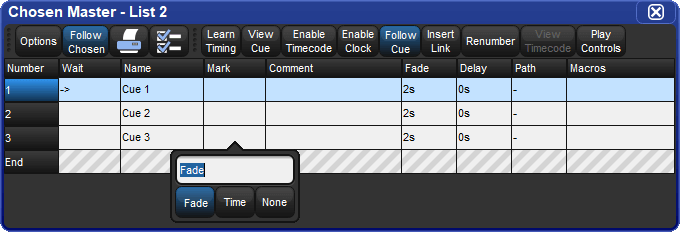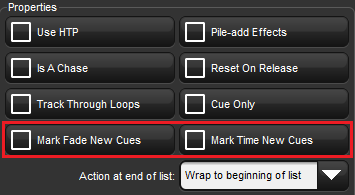A Mark cue is a special designator for a cue that looks at the previous cue and any fixtures with an intensity of zero after completion of the cue. If a fixture meets these requirements, the mark cue allows the fixture(s) to ‘preset’ for the next cue by executing the cross-fade for all parameters except intensity. This allows the fixture(s) to ‘move in black’ as they change to their new parameter values. When the next cue is later executed, only the intensity parameter changes as all other parameters will already be at their new values due to the mark. The timing used to mark a cue is determined by the mark method you choose. See Fade Mark verses Time Marks for details on the different timing methods you can use when marking cues.
There are several methods to assign a cue to mark:
Select the Mark cell of a cue, press Set, and then Enter. If you wish to "time mark" the cue, then first input a time using the keypad and then Enter. To remove the mark from a cue select the Mark cell of the cue, press Set, hit Backspace, and then Enter.
Enable the Mark Fade New Cues or Mark Time New Cues option in the Cuelist Options window. All new cues will be created with the mark type. Note that when Mark Time New Cues is selected all newly recorded cues will get a 2s mark time by default.
Toggle the Mark Fade or Mark Time button in a Cue Editor window of the cue you wish to mark.
Cues can be marked with either a fade mark or a time mark. While the basic principles of marking are the still the same, the timing in which the mark is executed varies between the two methods.
A Fade mark uses the fade and delay times assigned in the marked cue to mark fixtures. Fade marking occurs on a fixture by fixture basis, so several fixtures could be marking at different times and rates depending upon their individual cue data in the marked cue.
In the fade mark example below, when cue 2 completes its 2 second fade to 0% intensity, cue 3 will automatically play all of its data except intensity in a 5 second fade. Then when cue 3 is played only the intensity will cross-fade at 5 seconds. The fixtures will have moved from centre to left and changed from red to green automatically while in ‘black’.
|
Mark |
Fade |
Intensity |
Position |
Colour | |
|---|---|---|---|---|---|
|
Cue 1 |
2s |
100% |
Centre |
Red | |
|
Cue 2 |
2s |
0% |
Centre |
Red | |
|
Cue 3 |
Fade |
5s |
100% |
Left |
Green |
A Time mark uses the time you enter into the mark column to mark fixtures. Time marking occurs at a single uniform rate so all fixture parameters will mark at the same rate regardless of the data in the next cue.
In the time mark example below, when cue 2 completes its 2 second fade to 0% intensity, cue 3 will automatically play all of its data except intensity in a 0s second fade. Then when cue 3 is played only the intensity will cross-fade at 5 seconds. The fixtures will have moved from centre to left and changed from red to green automatically while in ‘black’.
|
Mark |
Fade |
Intensity |
Position |
Colour | |
|---|---|---|---|---|---|
|
Cue 1 |
2s |
100% |
Centre |
Red | |
|
Cue 2 |
2s |
0% |
Centre |
Red | |
|
Cue 3 |
0s |
5s |
100% |
Left |
Green |
![[Tip]](../images/tip.png) | Tip |
|---|---|
Marking occurs with the intensity parameter for standard fixtures as well as I Red, I Green, and I Blue parameters for RGB fixtures such as LEDs. |
If the first cue in a list is assigned to mark, it will only mark after the last cue in the list is played. By recording a blank cue prior to the first cue in the list, you can create a mark cue for the first look of a show. For example:
|
Mark |
Fade |
Intensity |
Position |
Colour | |
|---|---|---|---|---|---|
|
Cue 0.5 |
- |
- |
- |
- | |
|
Cue 1 |
Fade |
0,2s |
100% |
Right |
Blue |
|
Cue 2 |
2s |
50% |
Left |
- |
When cue 0.5 plays it will mark cue 1 so that cue 1 will fade up intensities on stage after the fixtures are already in position and color. Furthermore, since the intensity time of cue 1 is assigned to 2 seconds and the other parameters are assigned to zero, the mark cue will occur as quickly as possible.





